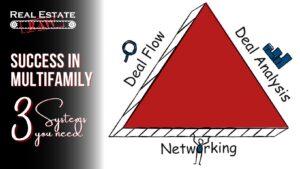Multifamily Underwriting vs. Valuation: What’s the Difference?
Underwriting is the process of calculating projected returns based on historical operating data and valuation comes from the combination of underwriting and an understanding of the physicality of the property itself.
Multifamily Underwriting is the process of analyzing a potential investment property to assess its financial viability based on the property’s past financial performance combined with a future projection (Proforma). Underwriting answers the question: “Is this property a good investment for me/partners/investors?”. The three “technical” methods to underwriting a multifamily investment are:
- Sales Comparison Approach: This compares the subject property to similar properties that have recently been sold in the area.
- Income Approach: This estimates the property’s value based on its potential income generation. Factors like rental income, vacancy rates, and operating expenses are considered.
- Cost Approach: This estimates the cost to replace the property, minus depreciation.
I say that this is the “technical” evaluation process because this is the main way a commercial appraiser will arrive at a valuation for your property. They will typically use all three whenever possible, and then weigh the results from each method to arrive at a final estimated value. The weight given to each approach can vary depending on the specific property and the availability of reliable data.
From the investors/buyer’s perspective we will also use the Income Approach and the Sales Comp approach mostly. The first step for a buyer is to evaluate the property from what I call The Three Pillars of Real Estate first mentioned in my book Creative Cash. These are the Three Pillars:
- Debt
- Exit Strategy
- Market Cycle
By understanding these three concepts you can use simple math to calculate the likelihood of a deal making money. This is what I call investment assurance. Not insurance but assurance. It comes from actually knowing what you are investing in! It’s all the latest rage these days.
Here is a summary of The Three Pillars:
- Debt- analyze the deal for the viability of getting a loan. How much will you need to put down and what is your debt service coverage ratio (DSCR)? Can you make a reasonable offer, or do you need to use some form of creative financing like Seller Financing or a Master Lease Option (MLO)?
- Exit Strategy- Do you have one? What are you going to do with the property? Long term hold and operate or quick fix and flip? Do you plan to sell or are you going to refinance the asset?
- Market Cycle- This one brings the other two together. When will your exit strategy occur (refi or sell)? What are the interest rates (inflation in general) doing right now? Where do you think rates will be when your exit strategy comes due? Buying a property with a short-term loan and low interest rates is risky if the interest rates go up before your planned exit. Short-term market cycles (rates) can greatly affect a sale or refinance.
By using the basic formulas for deal analysis while combining The Three Pillars of Real Estate you can not only determine the likelihood of profits you can do it with reasonable assurance of the investment.
Multifamily Valuation is the process of estimating the current market value of a multifamily property by combining the underwriting analysis plus a valuation of the physical asset. Valuation answers the question: “What is this property worth right now?”
Another way to look at multifamily valuation is by considering that an apartment complex is not only a property made up of the address, sticks, bricks, and mud but also it is a business.
Underwriting is the process of valuing the building from the business perspective (income, expenses, cashflow, etc.) and the valuation comes from adding the total cost/value of the building. A building in a good location will have a higher value than one in a lesser location. A newer building will have less cost in repairs and replacements therefore giving it a higher value. Here are a few items to consider when considering the value of the physical property itself:
- Location, Location, Location: Location ultimately equals appreciation. Appreciation is not just a “nice to have” in a multifamily investment. It is absolutely crucial. Know your market stats like crime, median income, household, and income/job growth for your area.
- CapEx or capital expenses: What is the general age and condition of the building itself? Old buildings will have aging (sometimes failing) infrastructure like plumbing, electrical, subflooring and parking just to name a few. Make sure to include the cost of these often “hidden” items or you will be paying for it with cashflow.
- Market Analysis: Analyzing rental trends, vacancy rates, and overall economic conditions in the area. Don’t rely on a single source for this info. Go to rental sites and active rental listings for current market data. Don’t be afraid to call some local properties and “secret shop” to check your information. Lastly, discount any info from anyone who would profit from selling you the asset. I am not saying the realtor and others would give you false data…I am just saying, buyer beware.
Unveiling the Investment Puzzle
Underwriting and valuation are two sides of the same coin, working together to guide your multifamily investment decisions. Underwriting assesses the property’s financial viability, while valuation determines its current market worth. By understanding both, you gain a comprehensive understanding of the property’s potential profitability and reduce risk.
Remember, a strong foundation is key to any successful investment. My Three Pillars of Real Estate – debt, exit strategy, and market cycle – provide a framework to analyze deals with “investment assurance.”
By combining these pillars with underwriting and valuation techniques, you’ll be well-equipped to not only identify good opportunities but also confidently navigate the complexities of the multifamily market.
So, the next time you encounter a potential multifamily investment, don’t just look at the bricks and mortar. Look deeper, analyze the financials, understand the market, and factor in your exit strategy.
For more information like this check out my blog HERE and join my Facebook group Real Estate Raw for Multifamily Investors.
Disclaimer: The information provided in this article is for general informational purposes only and should not be considered as financial advice. Please consult with a qualified financial advisor before making any investment decisions.
Best of luck!
Bill Ham


































